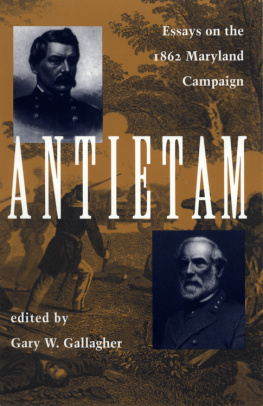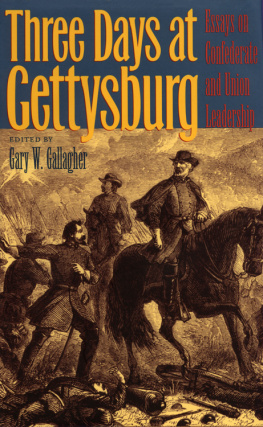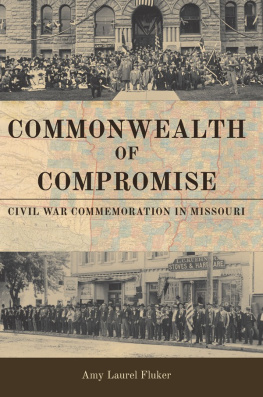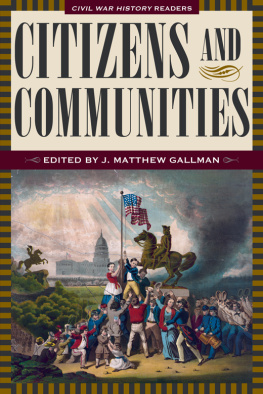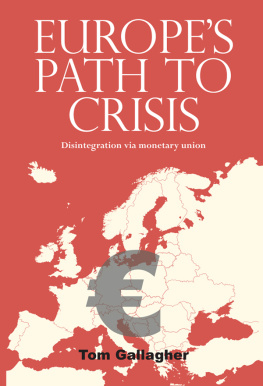THE ENDURING CIVIL WAR
CONFLICTING WORLDS
New Dimensions of the American Civil War
T. Michael Parrish, Series Editor
THE
ENDURING
CIVIL WAR
REFLECTIONS ON THE GREAT AMERICAN CRISIS
GARY W. GALLAGHER
LOUISIANA STATE UNIVERSITY PRESS
BATON ROUGE
Published by Louisiana State University Press
www.lsupress.org
Copyright 2020 by Gary W. Gallagher
All rights reserved. Except in the case of brief quotations used in articles or reviews, no part of this publication may be reproduced or transmitted in any format or by any means without written permission of Louisiana State University Press.
Manufactured in the United States of America
First printing
Designer: Barbara Neely Bourgoyne
Typeface: Whitman
Printer and binder: Sheridan Books
Jacket image: The Grand Review (1881), by James E. Taylor, courtesy of the Ohio History Center.
The appendix contains the publication history of all the essays reproduced in this book.
LIBRARY OF CONGRESS CATALOGING-IN-PUBLICATION DATA
Names: Gallagher, Gary W., author.
Title: The enduring Civil War : reflections on the great American crisis / Gary W. Gallagher.
Description: Baton Rouge : Louisiana State University Press, 2020. | Includes index.
Identifiers: LCCN 2019055078 (print) | LCCN 2019055079 (ebook) | ISBN 978-0-8071-7348-0 (cloth) | ISBN 978-0-8071-7406-7 (pdf) | ISBN 978-0-8071-7407-4 (epub)
Subjects: LCSH: United StatesHistoryCivil War, 18611865. | United StatesHistoryCivil War, 18611865Historiography.
Classification: LCC E468 .G3487 2021 (print) | LCC E468 (ebook) | DDC 973.7dc23
LC record available at https://lccn.loc.gov/2019055078
LC ebook record available at https://lccn.loc.gov/2019055079
Once again, for Joan
CONTENTS
ILLUSTRATIONS
ACKNOWLEDGMENTS
The number of people who contributed in some way to the ideas and arguments represented in these seventy-one essays is far too large to acknowledge. I do want to mention those who specifically helped with the book. Joan Waugh convinced me to gather the essays in a collection and offered her usual sound counsel at every stage of the work. Dana Shoaf cheerfully granted permission to reprint the essays from Civil War Times, as did Terry Johnston for those from the Civil War Monitor. Beyond this venture, I have enjoyed working with Dana and Terry as editors over many years. Mike Parrish, a much-valued friend and colleague for more than forty years, encouraged me to send the manuscript to LSU Press, and Rand Dotson, editor in chief at the press, provided welcome assistance at every stage of the process. Cecily N. Zander generously pointed me toward a number of very useful sources relating to the Civil War and the West. I completed the book while serving as the Rogers Distinguished Fellow in Nineteenth-Century American History at the Henry E. Huntington Library in San Marino, California. I am most grateful to Steve Rogers, as well as to Steve Hindle, the W. M. Keck Foundation Director of Research at the Huntington, for the opportunity to spend an academic year in what I consider ideal surroundings. I also benefited from the very helpful criticism of the other long-term fellows at the Huntington. Chris Heisey, whose photographs are well known in the world of Civil War photography, kindly allowed me to use his image of the Longstreet statue at Gettysburg. I offer my warmest thanks to all of these people, whose efforts in my behalf underscore the cooperative nature of book-length endeavors.
THE ENDURING CIVIL WAR
INTRODUCTION
T his book grew out of an invitation in the summer of 2008 to contribute brief essays to Civil War Times. Dana Shoaf, recently named editor, promised me the freedom to choose my own topics but said I would have to abide by a limit of one thousand words. The idea immediately appealed to me. I knew that Civil War Times had been established in 1962 and reached the largest popular audience in the field. In fact, it had been part of my life since I subscribed, in 1965, as a fourteen-year-old in Colorado captivated by the Civil War. The magazine published my first article, on Abraham Lincoln and black colonization, in 1980, and I subsequently contributed several more pieces. Many prominent historians had written for the magazineincluding academics such as Bell I. Wiley, Mary Elizabeth Massey, and T. Harry Williams, as well as authors whose books reached a large popular audience, such as Bruce Catton, Glenn Tucker, and Stephen W. Sears. I accepted Danas invitation, and the first essay appeared in April 2009. More than seventy others have followed.
Walt Whitman comes to mind as I look back on the experience of writing six short essays annually. In Specimen Days, the poet famously predicted, The real war will never get into the books. By that, Whitman meant the real story of the common soldiers, the actual soldier of 186265, North and South, as he explained. The seething hell and the black infernal background of countless minor scenes and interiors,... he suggested, will never be writtenperhaps must not and should not be. Indeed, the conflicts interior history will not only never be writtenits practicality, minutiae of deeds and passions, will never be even suggested. Whitmans observations inspire writers who search for a novel way to enter a crowded and popular field and strive to illuminate what they consider neglected or ignored elements of the war.
I approached writing the essays convinced that a great deal of the real war has gotten into the books. Gifted historians have produced a corpus of scholarship on the Civil War era that, together with the mass of testimony bequeathed by participants ranging from Abraham Lincoln to men in the ranks, from Freedmens Bureau workers to nurses and countless others, provides readers with bountiful options. For many decades, historians primarily dealt with causation, high politics, and conventional military operationsthree topics essential to a basic familiarity with the whole subject. Over the past half century, however, the literature has become much richer and more expansive. We know far more than previously about Whitmans common soldiers, about women in the United States and the Confederacy, about African Americans and the process of emancipation, about white unionists and other dissenters in the Confederacy, about guerrilla operations, about the conflict in a global context, and, increasingly, about the American West as part of the wars overall mosaic. Scholars also have accorded considerable attention to the so-called dark side of the conflictto its brutality, atrocities, cowardice, vicious activity by irregular bands, and physical and psychological wounds that left some veterans profoundly damaged.
As the field of Civil Warera history has become increasingly complex, there has been an understandable tendency to place a new subject as close as possible to the center of the entire story and to question many long-accepted analytical frameworks. The traditional juxtapositions of North and South, slaveholders and nonslaveholders, United States and Confederacy have come into question, as has the four-year time frame that typically delineates the subject in the popular imagination. Many scholars insist that the war must be brought together with post-Appomattox events, including Reconstruction, with the West and Native Americans, and with world history to create a long Civil War far more inclusive and geographically varied than the one dominated by events that transpired east of the Mississippi River, and especially in Virginia, from 1861 to 1865.
From the beginning, I wanted my essays for Civil War Times to expose tensions among parts of the recent literature that cover peripheral or secondary dimensions of the conflict and what I would call four foundational elements of the real war (to continue with Whitmans phrasing, if not his narrow meaning regarding common soldiers). Some new writings, however useful and praiseworthy, obscure realities that stand out clearly in the evidence and should be as apparent to us as they were to the wartime generation: The real war erupted over slavery-related political issues between North and South and retained that internal focus. Conventional armies decided its outcome, fielding millions of citizen-soldiers who waged some of the most famous and costly campaigns in American history. It ended in the early summer of 1865, having settled the issue of secessions constitutionality and destroyed the institution of slavery but leaving the question of equal rights for freedpeople unresolved. The twelve years of Reconstruction functioned as a long coda to the war itself, again centered on a clear central issuehow ten former Confederate states would return to the reconstituted Union (Tennessee was exempted from most of Reconstruction) and how that process would affect African American political rights and economic circumstances. Anyone who grasps these four things has made a very good start toward gaining a general understanding of the real war.
Next page

